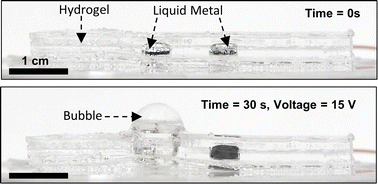Soft electrochemical bubble actuator with liquid metal electrode using an embodied hydrogel pneumatic source†
Abstract
Soft pneumatic actuators—such as those used for soft robotics—achieve actuation by inflation of pneumatic chambers. Here, we report the use of the electrochemical reduction of water to generate gaseous products that inflate pneumatic chambers. Whereas conventional pneumatic actuators typically utilize bulky mechanical pumps, the approach here utilizes only electricity. In contrast to dielectric actuators, which require ∼kV to actuate, the electrochemical approach uses a potential of a few volts. The applied potential converts liquid water—a safe, abundant, and cheap fuel—into hydrogen gas. Since the chambers are constructed of hydrogel, the body of the actuator provides an abundant supply of water that ultimately converts to gas. The use of liquid metal for the electrode makes the entire device soft and ensures intimate contact between the chamber walls and the electrode during inflation. The device can inflate in tens of seconds, which is slower than other pneumatic approaches, but much faster than actuating hydrogels via principles of swelling. The actuation volume can be predicted and controlled based on the input parameters such as time and voltage. The actuation shape and position can also be controlled by the position of the electrodes and the geometry of the device. Such actuators have the potential to make tether-less (pump-free), electrically-controlled soft devices that can even operate underwater.

- This article is part of the themed collection: Soft Robotics


 Please wait while we load your content...
Please wait while we load your content...